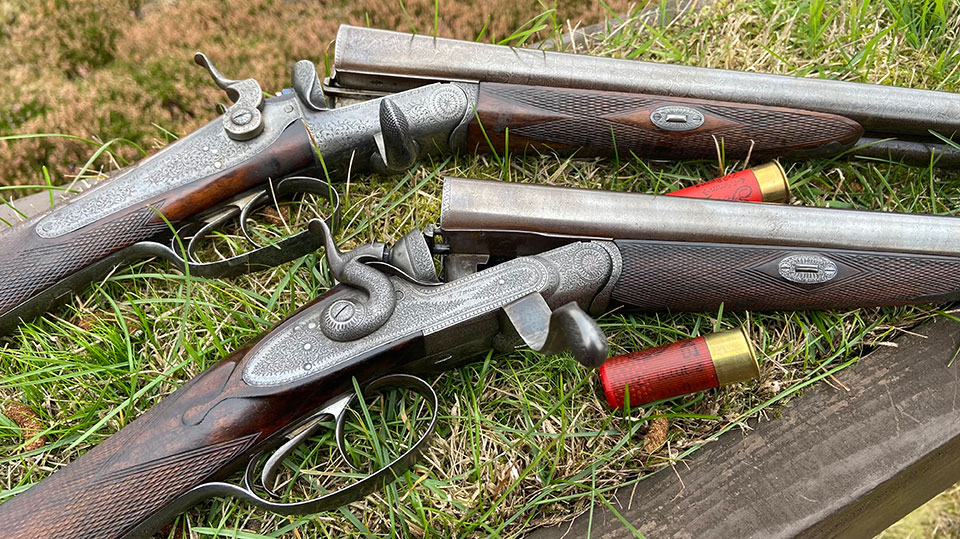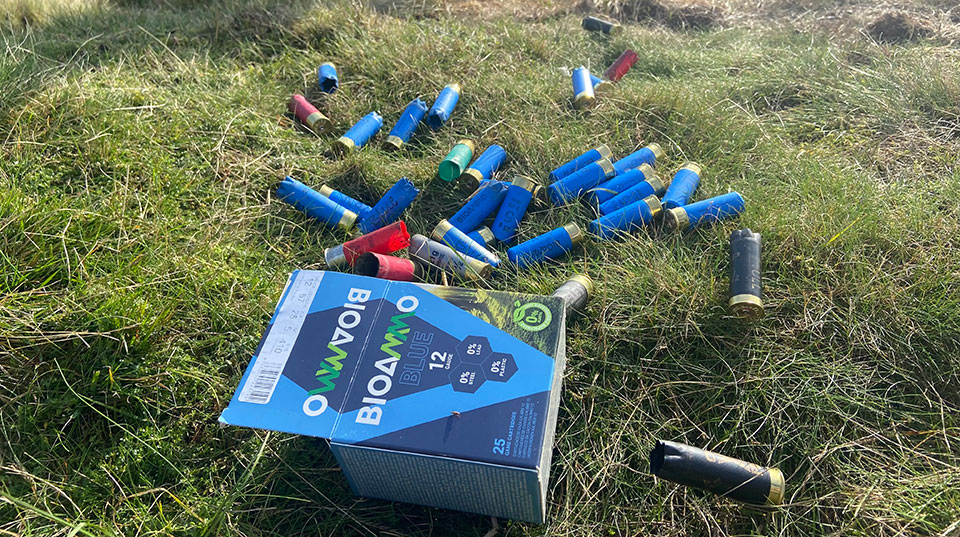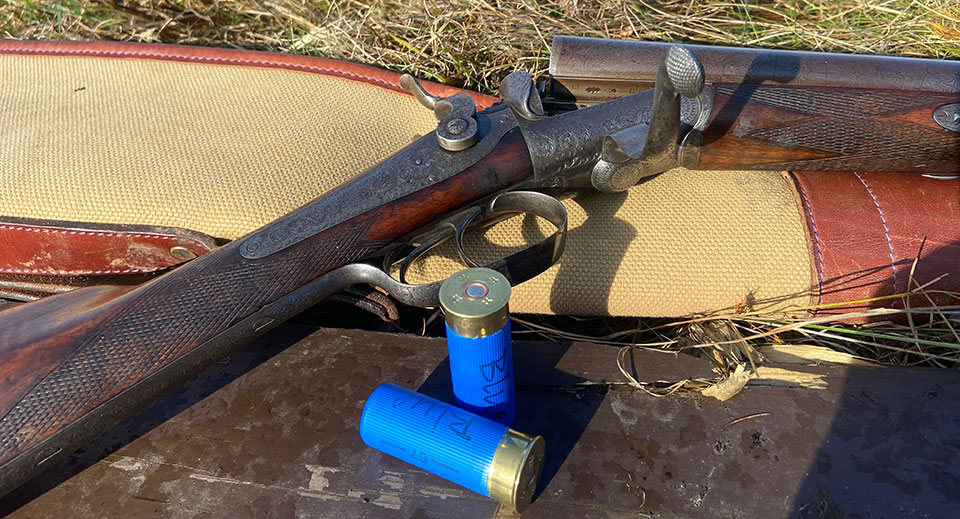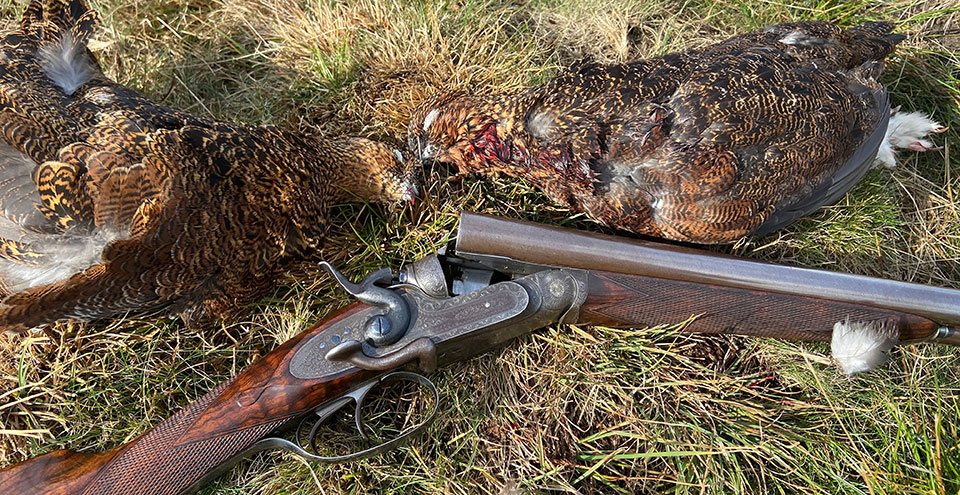We have all read a lot about the data comparing lead shot with the various non-lead alternatives that we are all being warned will become the norm in the future.
For users of British guns, especially older ones, there is a natural concern that the new alternatives will either be unsuited to the guns we use or ineffective in the field.
I decided to conduct an informal experiment this late September when I headed to Cumbria, with a boot full of kit, for a couple of days on the grouse.
 We started with the pair of hammer guns and lead shot.
We started with the pair of hammer guns and lead shot.
Allenheads and Muggleswick were to be the moors hosting our party Nick Harlow and Dan Jago from Purdey would be wielding modern Purdey over & unders, Trigger, M.D. of Westley Richards was using his battered pair of Mirokus and Kiri was using his Brownings.
I could have packed a pair of side-locks but these days I shoot to please myself and so I packed two non-rebound lock under-lever hammer guns (one by Thorn, the other by John Emme), my 16-bore Grant sidelever hammer gun and ‘Trusty Rusty’ my old J. Thompson hammer gun. Between them, they should keep me amused; and my loader on his toes!
As for ammunition, I gathered together a very mixed bag of 12-bore lead cartridges, some sensible 16-bore lead loads and some non-lead shells with which to compare them.
The plan was to start shooting with lead and, once in the swing, to swap to an alternative and see if there was any change in my fortunes. Would I see fewer birds hitting the heather after the change-over?
Now, I realise this is not a scientific study and results are subject to lots of irritating variables which would rightly draw challenges to any conclusions I eventually make. However, most shooting men I talk to really just want to know if the new stuff works when you shoot at birds with it.
 We switched to BioAmmo on the first drive of Day 2.
We switched to BioAmmo on the first drive of Day 2.
The non-lead ammunition I took with me was:
12-bore BioAmmo Blue (67mm cases). No.5 shot 27g load.
12-bore Dickson ‘Steel Thistle’ (made by Hull)
16-bore Eley VIP Bismuth (65mm cases) 26.5g load.
So, with BioAmmo, steel and bismuth being the front runners as alternatives to lead shot, we have all bases covered. All the guns have Damascus barrels, so I was wilfully ignoring the labels on the boxes warning against this practice.
I probably have to justify that statement. Makers put that warning on boxes to ‘cover their collective arse’ to use a common vulgarism. Too many old guns with Damascus barrels are in poor condition, with thin walls and enlarged bores. It is unreasonable to expect the general public to know how to determine barrel condition - so a blanket ‘ban’ or warning protects manufacturers of ammunition from legal jeopardy in case of mishap.
I measured all my guns’ bores and barrels to make sure they were in good order and examined them carefully to satisfy myself they were in materially sound condition.
For the record, Damascus steels were put into trials in the 19th century, alongside fluid-pressed steel barrels, and proved to be just as robust, in many cases more so, when tested to destruction.
 These are 25g loads of No.5. No lead, no plastic.
These are 25g loads of No.5. No lead, no plastic.
So, with guns and ammunition packed into the boot of the GT, I ventured into the early afternoon sunshine, turned northwards and headed for the M6. In a little over four hours we would be pulling into the gravelled driveway of Naworth Castle, our home for the next three nights.
I began shooting with the composed pair of non-rebound lock, under-lever hammer guns by Thorn and Emme. My loader, Caleb coped manfully with my non-standard kit and we were able to keep up with the pace nicely, though the grouse were already starting to pack-up and some came through in big numbers.
Shooting lead for the first day, we were getting a bit of shooting and accounted for thirty birds in total. On day two, we started with the Bio-Ammo Blue and I have to say it was not a good start.
My shot-to kill ratio dropped noticeably. In-fact, towards the end of the drive I started to connect more reliably and commented that they were now bringing birds to bag. Unfortunately, the reply from Caleb was that he had switched to lead without telling me as the Bio-Ammo was not apparently doing the job.
 The 16-bore Grant, used with lead and bismuth.
The 16-bore Grant, used with lead and bismuth.
Confidence rather battered by the experience, we reverted to lead shot for the rest of the day. That is until the last drive, where I switched to the 16-bore Grant and a mixed bag of bismuth and lead in blue cases. Both were pleasant to shoot and I don’t know what cartridges bagged the grouse and which did not. I have some experience with bismuth and previous trials have shown it to be effective on waterfowl.
And so concluded my small experiment with non-lead alternatives on the grouse moor. I will continue my trials in October with a trip to Inverness for back-to back pheasant and partridge days and in November when I have four days of the same here in Shropshire.
I hope to be able to ascertain a discernible in-field confidence (or lack of it) when using these new loads. I also hope to be able to report back that they become more familiar and allow for success in the kind of driven shooting situations most of us find ourselves at some point each season.
For now, the jury is out but the informal experiment goes on.
Curtesy of Diggory Hadoke
https://www.vintageguns.co.uk/